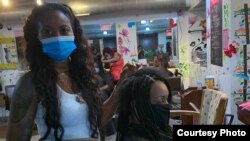Three months ago Kemi Lawani, who owns a small hair salon in south Minneapolis, spent many nights crying, worried about how to pay the bills and feed her kids in the midst of the coronavirus shutdown that closed her business and thousands of others across the state for more than two months last spring.
“You don’t know what is going to happen. The anxiety is very high,” she said at the time.
Just as she was getting ready to reopen, the Minneapolis neighborhood where her business is located was hit by protests and rioting after the death of George Floyd in police custody in late May. And after the Floyd protests, the neighborhood saw an uptick in gun violence.
Lawani’s salon, Bonitas Extensions and Braids, was not damaged during the demonstrations. So she partially reopened in early June, selling hair care products from her shop. She opened for hair styling last week.
With the help of a GoFundMe page, a federal Payroll Protection Loan and state unemployment benefits, Lawani was able to pay salaries and the rent and put food on the table.
Her two employees are not coming back because of safety concerns and health issues, but she plans to hire new workers, restructure her business and make it work.
Three months ago, she wasn’t sure she would be able to survive.
Unemployment in Minnesota
As of June 30, just under 270,000 Minnesotans, or 8.6 percent of the workforce, were unemployed, according to the Minnesota Department of Employment and Economic Development. That compares with an 11.1 percent national jobless rate at that time. The national rate at the end of July had fallen to 10.2 percent. Minnesota’s unemployment rate is still double what it was prior to the pandemic.
The state's new coronavirus cases slowed in late spring but have begun to rise, particularly among younger people, since June 10 when bars and restaurants began partial reopening. As of August 7, the state has recorded 60,101 cases and 1,648 deaths, the majority of whom were nursing home or assisted living patients, according to the Minnesota Department of Health.
Nationally, there have been more than 5 million cases and 163,156 deaths as of August 10, according to data from the Johns Hopkins School of Medicine.
“We will see who comes back,” Lawani said of her 100 regular clients. “I need to get at least 75 percent of my former customers to keep us afloat. I believe customers will come back because I stayed in communication with them, letting them know what’s going on. Everyone is excited.”
She feels fortunate that she will be able to restart her business, which she has run for 11 years in Minneapolis, the largest city in the state.
“Three small-business people I know aren’t coming back,” she said. “I’m going to restructure on a smaller scale and keep doing what I love to do.”
Lawani thinks her customers will all want to talk about the impact of COVID-19 on the community and the property damage caused in the rioting. As a Nigerian American and a woman of color, Lawani supported the mostly peaceful protests following Floyd’s killing.
“The way they were protesting was OK,” she said. “No one should have to go through what that man (George Floyd) went through. I have kids. I have a black son. Having a black son only instills fear in you because I worry about his going out and never coming home. It is really understandable that people should protest.”
On the other hand, she said, the violence was counterproductive.
“Personally, I always think violence doesn’t solve anything,” she said. “Destroying businesses is like destroying people’s livelihood. … It’s very touchy because you don’t want to say something and have people angry at you. My mom taught us sometimes you have to be quiet.”
In crisis
In the midst of the pandemic and the shutdown last spring, Lawani found herself crying in front of her daughter Zeal, who is 13 years old. “My daughter knows what’s going on,” Lawani said at the time.
Now, she said, “my kids are doing well. It is hard for them. They see everything that is going on. I let them know we stick together through all the things going on.” When she went back to work in June, her daughter gave her a mask as a gift, “a sign of making sure that I stay safe,” Lawani said.
The next challenge for her kids is how Minnesota schools will try to reopen this fall: in class, at home or a hybrid of the two. Her son, Zion, who is 2, will be in day care.
She hopes that her daughter will be in school. “I am not worrying about safety at school,” she said. “She is cautious and follows the rules, and the parents and teachers are wearing masks. If this is going to be the norm, we have to move on.”
After three months of struggle and worrying whether her business would survive and how she would care for her children, Lawani said she is optimistic about the future.
“I’m not worried about the future of my business,” she said confidently. “Every business has to create something that is systemic. You have to create a system that works for you and your clients. … Everything that has happened has opened an opportunity for me. I was scared at first … I think I will be fine.”








